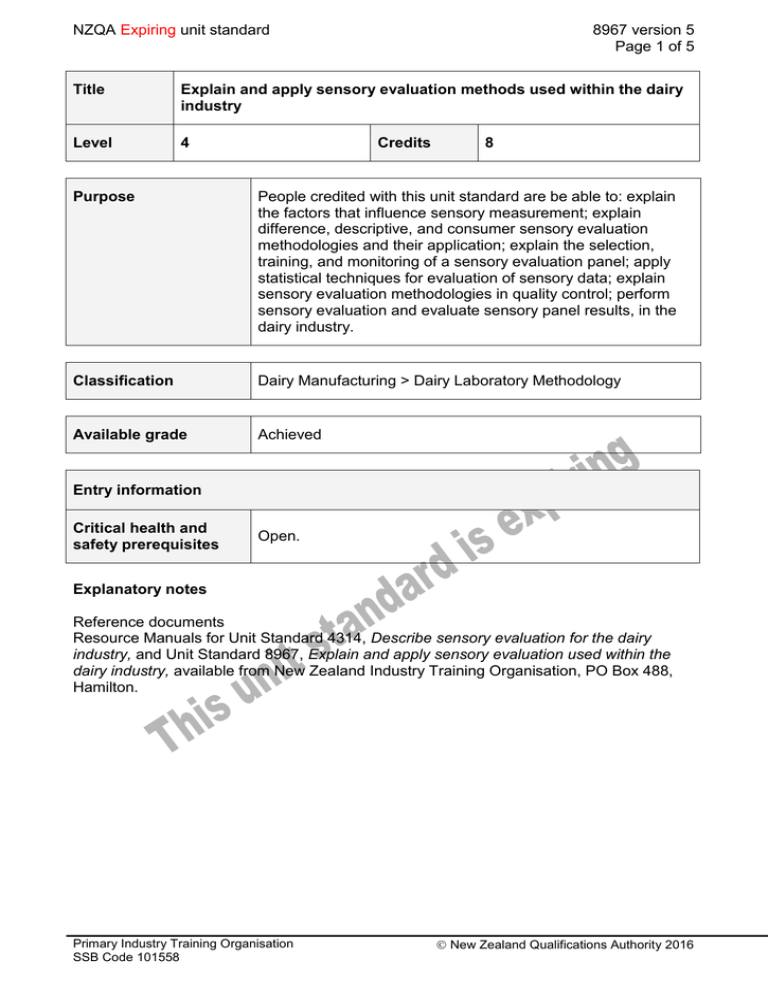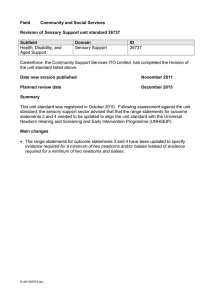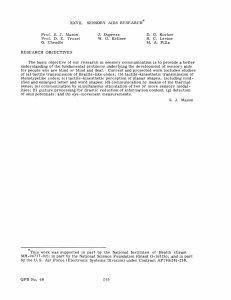NZQA unit standard 8967 version 5
advertisement

NZQA Expiring unit standard 8967 version 5 Page 1 of 5 Title Explain and apply sensory evaluation methods used within the dairy industry Level 4 Credits 8 Purpose People credited with this unit standard are be able to: explain the factors that influence sensory measurement; explain difference, descriptive, and consumer sensory evaluation methodologies and their application; explain the selection, training, and monitoring of a sensory evaluation panel; apply statistical techniques for evaluation of sensory data; explain sensory evaluation methodologies in quality control; perform sensory evaluation and evaluate sensory panel results, in the dairy industry. Classification Dairy Manufacturing > Dairy Laboratory Methodology Available grade Achieved Entry information Critical health and safety prerequisites Open. Explanatory notes Reference documents Resource Manuals for Unit Standard 4314, Describe sensory evaluation for the dairy industry, and Unit Standard 8967, Explain and apply sensory evaluation used within the dairy industry, available from New Zealand Industry Training Organisation, PO Box 488, Hamilton. Primary Industry Training Organisation SSB Code 101558 New Zealand Qualifications Authority 2016 NZQA Expiring unit standard 8967 version 5 Page 2 of 5 Outcomes and evidence requirements Outcome 1 Explain the factors that influence sensory measurement. Evidence requirements 1.1 The influence of the testing environment on sensory measurement is explained. Range 1.2 The influence of sample preparation and presentation on sensory measurement is explained. Range 1.3 optimum settings, light, air source, colour, temperature, humidity, personal comfort. uniformity, temperature, size, shape, random order, blind codes, rinsing. The influence of biases and errors on sensory measurement is explained. Range expectation error, stimulus error, logical error, suggestion, contrast effect, positional effect. Outcome 2 Explain difference, descriptive, and consumer sensory evaluation methodologies and their application. Evidence requirements 2.1 A sensory evaluation method is selected with supporting reasons for given situations. Range 2.2 Difference tests methodologies are explained. Range 2.3 pair comparisons, triangle, duo-trio, difference from control. Descriptive sensory evaluation methods are explained. Range 2.4 customer complaint, product development, loss of market share, quality control. flavour profile method, texture profile method, Quantitative Descriptive Analysis (QDA), descriptive profiling. Consumer evaluation versus trained sensory panel evaluation methods is explained. Range preference, acceptance, central location, in-home placement, focus groups. Primary Industry Training Organisation SSB Code 101558 New Zealand Qualifications Authority 2016 NZQA Expiring unit standard 8967 version 5 Page 3 of 5 Outcome 3 Explain the selection, training, and monitoring of a sensory evaluation panel. Evidence requirements 3.1 The factors influencing selection of sensory evaluation panellists are explained. Range 3.2 Procedures for training of sensory evaluation panellists are explained. Range 3.3 availability, group interaction, taste ranking, triangle test, odour recognition. reference scales, reference standards, product attributes, panel motivation. Procedures for monitoring the performance of sensory panels are explained. Range individual panellist’s results, sensory panel performance. Outcome 4 Apply statistical techniques for evaluation of sensory data. Evidence requirements 4.1 The mean, median, standard deviation (n-1), and range are calculated for a given set of data. Range 4.2 whole numbers 0-9. The statistical results from performance criterion 4.1 are interpreted. Range validity, implication of variability, implication for training. Outcome 5 Explain sensory evaluation methodologies in quality control. Evidence requirements 5.1 Sensory quality control methods are explained. Range NZ Quality Control history, Difference From Control (DFC), Attribute Evaluation, Defect Attribution, Typical/Atypical. Outcome 6 Perform sensory evaluation and evaluate sensory panel results. Primary Industry Training Organisation SSB Code 101558 New Zealand Qualifications Authority 2016 NZQA Expiring unit standard 8967 version 5 Page 4 of 5 Evidence requirements 6.1 Flavour evaluations for six samples are performed as an individual sensory panellist. Range 6.2 sweetness, sourness, creaminess. Sensory panel results are evaluated statistically in accordance with a given sensory profile. Range mean, median, standard deviation (n-1), range. Replacement information This unit standard and unit standard 4314 have been replaced by unit standard 28671. This unit standard is expiring. Assessment against the standard must take place by the last date for assessment set out below. Status information and last date for assessment for superseded versions Process Version Date Last Date for Assessment Registration 1 28 April 1997 31 December 2018 Revision 2 2 July 1999 31 December 2018 Revision 3 13 June 2003 31 December 2018 Review 4 16 December 2005 31 December 2018 Review 5 17 September 2015 31 December 2018 Consent and Moderation Requirements (CMR) reference 0022 This CMR can be accessed at http://www.nzqa.govt.nz/framework/search/index.do. Please note Providers must be granted consent to assess against standards (accredited) by NZQA, before they can report credits from assessment against unit standards or deliver courses of study leading to that assessment. Industry Training Organisations must be granted consent to assess against standards by NZQA before they can register credits from assessment against unit standards. Providers and Industry Training Organisations, which have been granted consent and which are assessing against unit standards must engage with the moderation system that applies to those standards. Requirements for consent to assess and an outline of the moderation system that applies to this standard are outlined in the Consent and Moderation Requirements (CMR). The CMR also includes useful information about special requirements for organisations wishing Primary Industry Training Organisation SSB Code 101558 New Zealand Qualifications Authority 2016 NZQA Expiring unit standard 8967 version 5 Page 5 of 5 to develop education and training programmes, such as minimum qualifications for tutors and assessors, and special resource requirements. Primary Industry Training Organisation SSB Code 101558 New Zealand Qualifications Authority 2016





